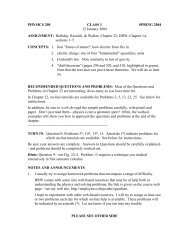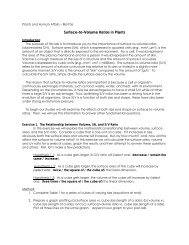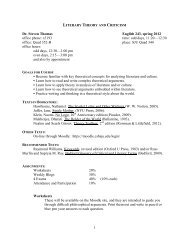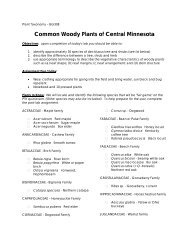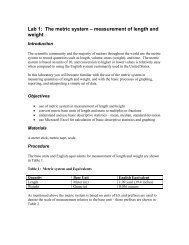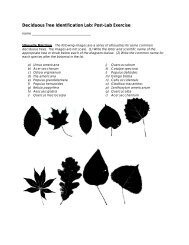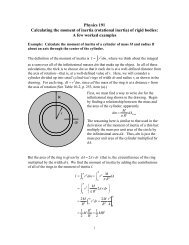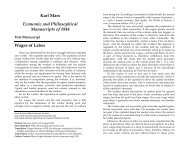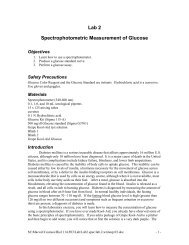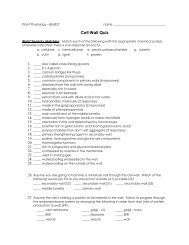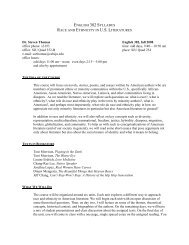Exercise: How many stereoisomers does an octahedral complex ...
Exercise: How many stereoisomers does an octahedral complex ...
Exercise: How many stereoisomers does an octahedral complex ...
You also want an ePaper? Increase the reach of your titles
YUMPU automatically turns print PDFs into web optimized ePapers that Google loves.
Isomerism in Octahedral Tr<strong>an</strong>sition Metal Complexes <br />
As you have seen in the chemistry of carbon‐containing compounds, often there are several isomers <br />
possible for the same compound formula. Even when atoms are connected in the same order it is <br />
possible that we have not uniquely described the structure of the molecule. For example, because there <br />
is no free rotation about a double bond, the cis <strong>an</strong>d tr<strong>an</strong>s isomers are separate entities with different <br />
properties. This type of isomerism is referred to as disasteromerism (or geometric isomerism or cistr<strong>an</strong>s isomerism). Alternatively , if the four groups surrounding a tetrahedral atom are not the same, the <br />
molecule is not superimposable on its mirror image. Molecules not superimposable on their mirror <br />
images are called en<strong>an</strong>tiomers (or optical isomers). <br />
Because carbon obeys the octet rule, there are at most four different groups <strong>an</strong>d two en<strong>an</strong>tiomers <br />
possible per tetrahedral carbon. But what happens when there are more th<strong>an</strong> four groups around a <br />
central atom This commonly happens in tr<strong>an</strong>sition metal chemistry where there are often six groups <br />
(called lig<strong>an</strong>ds) around a central metal atom. [ In fact, if there are six different groups in <strong>an</strong> <strong>octahedral</strong> <br />
arr<strong>an</strong>gement around a metal atom, there are 15 different geometric isomers, <strong>an</strong>d each one exists as a <br />
pair of en<strong>an</strong>tiomers, for a total of thirty <strong>stereoisomers</strong>!] This activity will introduce you to a systematic <br />
way to determine the number of geometric <strong>an</strong>d optical isomers in <strong>an</strong> <strong>octahedral</strong> tr<strong>an</strong>sition metal <br />
<strong>complex</strong>. <br />
Before you begin, you should be familiar with the common lig<strong>an</strong>ds that c<strong>an</strong> connect to a tr<strong>an</strong>sition <br />
metal. There is such a list on page 825 of your textbook. Note that <strong>m<strong>an</strong>y</strong> donate one pair of electrons <br />
(monodentate lig<strong>an</strong>ds) while others donate two pairs of electrons (from different atoms in the lig<strong>an</strong>d). <br />
The latter are called bidentate lig<strong>an</strong>ds. In <strong>an</strong> <strong>octahedral</strong> <strong>complex</strong> there are a total of six pairs of <br />
electrons around the metal ion. These pairs c<strong>an</strong> come from six monodentate lig<strong>an</strong>ds, three bidentate <br />
lig<strong>an</strong>ds, a bidentate lig<strong>an</strong>d <strong>an</strong>d four monodentate lig<strong>an</strong>ds, or <strong>an</strong>y other combination that you c<strong>an</strong> think <br />
of. By knowing the names <strong>an</strong>d abbreviations of the lig<strong>an</strong>ds you c<strong>an</strong> determine number of electron pairs <br />
around the metal ion. <br />
Let’s do <strong>an</strong> example. Determine the number of geometric <strong>an</strong>d optical isomers of [Co(NH 3 ) 3 BrClF]. <br />
<br />
Quick check—we have six monodentate lig<strong>an</strong>ds attached to the cobalt, so this should be <strong>an</strong> <strong>octahedral</strong> <br />
<strong>complex</strong>. <br />
<br />
1. Draw one isomer. (It <strong>does</strong>n’t matter which one.) In this case we <br />
c<strong>an</strong> abbreviate the lig<strong>an</strong>d names further, as long as doing so <br />
<strong>does</strong>n’t create confusion—for example NH3 =N. <br />
2. Lig<strong>an</strong>ds that are 180 o to each other are said to be tr<strong>an</strong>s. <br />
Describe the isomer by writing tr<strong>an</strong>s pairs in parentheses. Thus, <br />
the structure drawn here is (Br, N), (Cl, F), (N, N). Each <br />
geometric isomer will have a unique combination of tr<strong>an</strong>s lig<strong>an</strong>ds. You c<strong>an</strong> avoid confusion by <br />
alphabetizing lig<strong>an</strong>ds both within the parentheses <strong>an</strong>d among the set of three tr<strong>an</strong>s pairs. If you <br />
do this, it allows you to easily recognize whether <strong>an</strong>other structure is just <strong>an</strong>other picture of <br />
what you have already drawn or a unique isomer. <br />
<br />
Example‐ Does the following represent a new geometric isomer of the <strong>complex</strong>: <br />
<br />
<br />
<br />
<br />
<br />
<br />
<br />
3. Lig<strong>an</strong>ds that are 90 o to each other are said to be cis. Now try switching a pair of cis lig<strong>an</strong>ds <strong>an</strong>d <br />
drawing the picture. (You c<strong>an</strong> avoid drawing repeat structures if you switch just two lig<strong>an</strong>ds at a <br />
time rather th<strong>an</strong> r<strong>an</strong>domly drawing a new structure.) Use the method for describing the <br />
<strong>complex</strong>’s lig<strong>an</strong>ds as given in #2. Is it the same isomer as one you already have Continue this <br />
process until you c<strong>an</strong>’t generate <strong>an</strong>y new structures. <br />
Example—draw all of the remaining geometric isomers for [Co(NH 3 ) 3 BrClF]. Under each one that you <br />
draw, list the lig<strong>an</strong>ds in tr<strong>an</strong>s pairs as described above. (Hint—there are a total of four, including the <br />
first one already shown.) <br />
<br />
<br />
<br />
<br />
<br />
<br />
4. If the <strong>complex</strong> contains a bidentate lig<strong>an</strong>d, the ends of that lig<strong>an</strong>d must occupy cis sites around <br />
the octahedron. (For all common lig<strong>an</strong>ds, the chain of atoms connecting the atoms attached to <br />
the metal ion is not long enough for the atoms in the same bidentate lig<strong>an</strong>d to be across from <br />
each other.) Connect the atoms in a bidentate lig<strong>an</strong>d with a line. <br />
Thus, en= .
<br />
5. For each geometric isomer, there is the possibility that its mirror image is non‐superimposable. <br />
If so, that isomer exists as a pair of en<strong>an</strong>tiomers. There are two ways of determining this. First, <br />
you could build a model of the isomer, build its mirror image, <strong>an</strong>d then attempt to lay the two <br />
models on top of each other. If you c<strong>an</strong> get all of the atoms to align, the mirror image is <br />
superimposable <strong>an</strong>d you just have two copies of the same thing. If you c<strong>an</strong>’t get them to align, <br />
then the two structures are en<strong>an</strong>tiomers <strong>an</strong>d represent different ways of arr<strong>an</strong>ging the atoms. <br />
The second method is really just a variation on the first but <strong>does</strong> not involve building models. In <br />
this case, look for a mirror pl<strong>an</strong>e within the molecule. If there is a pl<strong>an</strong>e within the molecule <br />
such that one half of the molecule is identical to the other half, then the mirror image WILL be <br />
superimposable on the original. If there are no such pl<strong>an</strong>es then the structure will exist as a pair <br />
of en<strong>an</strong>tiomers. There are several “trial” pl<strong>an</strong>es that we might look at. Three are shown below. <br />
<br />
<br />
<br />
<br />
In the first one, the pl<strong>an</strong>e contains two tr<strong>an</strong>s N’s, the Cl <strong>an</strong>d the F. (All pl<strong>an</strong>es must also contain the <br />
central atom.) Any atom that is in the selected pl<strong>an</strong>e reflects into itself. Note that the Br <strong>an</strong>d one of the <br />
N’s are outside of the pl<strong>an</strong>e. If this represented a pl<strong>an</strong>e of symmetry within the molecule, the reflection <br />
of the Br would have to be <strong>an</strong>other Br. Since there is <strong>an</strong> N on the opposite side of the mirror from the <br />
Br, this site <strong>does</strong> not represent a mirror pl<strong>an</strong>e of symmetry within the structure. So, let’s look at the <br />
second picture. In this case a mirror pl<strong>an</strong>e containing N, F Br <strong>an</strong>d Cl is shown (perpendicular to the pl<strong>an</strong>e <br />
of the paper). This reflects <strong>an</strong> N into <strong>an</strong>other, so there is a mirror pl<strong>an</strong>e of symmetry in this location. In <br />
the third picture, a mirror pl<strong>an</strong>e is showing passing between the Br <strong>an</strong>d Cl, <strong>an</strong> N <strong>an</strong>d <strong>an</strong> F <strong>an</strong>d containing <br />
the other two N’s (this is the pl<strong>an</strong>e containing the paper). This pl<strong>an</strong>e would reflect the Br into the Cl <br />
(<strong>an</strong>d the F into the N) so it c<strong>an</strong>not be a symmetry pl<strong>an</strong>e. Because we have found one symmetry pl<strong>an</strong>e <br />
within the molecule, this isomer will be superimposable on its mirror image <strong>an</strong>d thus will not exist as <br />
optical isomers. <br />
Note—when looking for symmetry pl<strong>an</strong>es in molecules containing bidentate lig<strong>an</strong>ds, you must take into <br />
account the part of the molecule that connects the two ends of the bidentate lig<strong>an</strong>d. <br />
Example: Examine the geometric isomers you have drawn for [Co(NH 3 ) 3 BrClF]. For those that have one, <br />
draw a symmetry pl<strong>an</strong>e within the molecule. (Hint—there is one isomer that <strong>does</strong>n’t have a symmetry <br />
pl<strong>an</strong>e.)
Isomerism in Octahedral Tr<strong>an</strong>sition Metal Complexes <br />
Takehome points: (These points are more completely explained earlier.) Carefully read it for complete <br />
expl<strong>an</strong>ation.) To determine the number of possible isomers (geometric <strong>an</strong>d optical) for <strong>an</strong> <strong>octahedral</strong> <br />
tr<strong>an</strong>sition metal <strong>complex</strong>, <br />
1. Draw one isomer with the lig<strong>an</strong>ds arr<strong>an</strong>ged in <strong>an</strong>y convenient way. <br />
2. Write each of the three pairs of tr<strong>an</strong>s lig<strong>an</strong>ds enclosed in a set of parentheses <br />
3. Switch a pair of cis lig<strong>an</strong>ds <strong>an</strong>d describe the new <strong>complex</strong> using the method in #2. If two structures do <br />
not have the same sets of tr<strong>an</strong>s pairs of lig<strong>an</strong>ds, they are geometric isomers. <br />
4. The different ends of bidentate lig<strong>an</strong>ds must occupy cis sites around the octahedron. <br />
5. Examine each geometric isomer for internal mirror pl<strong>an</strong>es. If there are no such mirror pl<strong>an</strong>es, that <br />
geometric isomer will exist as a pair of en<strong>an</strong>tiomers. <br />
<br />
Practice: for each of the following <strong>complex</strong>es, draw all geometric isomers <strong>an</strong>d label them using the <br />
“tr<strong>an</strong>s pair” naming system. Indicate which exist as a pair of en<strong>an</strong>tiomers. <br />
A. [Cr(H 2 O) 3 (OH) 2 Cl] <br />
<br />
<br />
<br />
<br />
<br />
<br />
<br />
<br />
<br />
<br />
<br />
<br />
B. [M(NH 3 ) 2 Cl 2 F 2 ] <br />
C. [Ni(en)(ox)(H 2 O)(NH 3 )]



